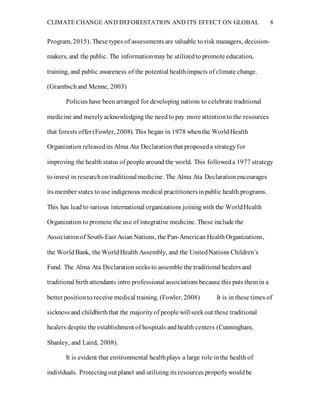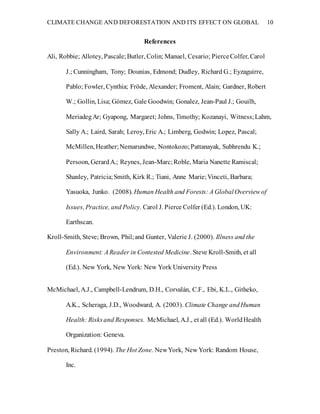EH Research paper
- 1. Running head: CLIMATE CHANGE AND DEFORESTATION AND ITS EFFECT 1 Climate Change and Deforestation and its Effect on Global Public Health Autumn Funderburg Ohio University
- 2. CLIMATE CHANGE AND DEFORESTATION AND ITS EFFECT ON GLOBAL 2 Hippocrates was one of the first to discover alink between the environment and health of human beings. He tooknote that physicians of the time should have “due regardof the seasons of the year, and the diseases whichthey produce, and the states of the wind peculiar to each countryand the qualities of its water (McMichael, 2003). Varying among geographies and topographies, environmental healthimpacts may be positive or negative, but is predictedby scientists to be predominantly negative (McMichael, 2003). Environmental health conditions playa significant role in foodtravel and importation, famine, starvation, social collapse andthe disappearance of whole populations (McMichael, 2003). These conditions maylead to social unrest that may include robberies, riots, cannibalism, and animal disease proliferation(McMichael, 2003). Climate change and deforestationare important to the general wellbeing of a society, with the potential to impact foodproductionlevels and the spreadof infectious diseases. The United States and the world are experiencingclimate change: increases in temperatures, global risingof sealevels, and many types of extreme weather. All are becomingmore frequent and more severe (U.S. Global Change ResearchProgram, 2015). Accordingto Figure 1.5 onpage 10 of Climate Change and Human Health, the first directlyaffectedareais the regional weather. This can include heat waves, extreme weather, temperature, and precipitation. This may have a seasonal link and, for example, a mild winter can lead to summer seasonal changes involving extreme heat waves more than typical of the region. These regional weather changes affect microbial contaminationpathways, transmissiondynamics, agro-ecosystems and hydrology, and socioeconomicconditions anddemographic conditions. This in turn,
- 3. CLIMATE CHANGE AND DEFORESTATION AND ITS EFFECT ON GLOBAL 3 has an effect onhealth that can include temperature relatedillness anddeath, extreme weather relatedhealtheffects, air pollution-relatedhealtheffects, water and food borne diseases, vector borne and rodent diseases, effects of foodand water shortages, mental, nutritional, infections and other healtheffects (McMichael, 2003). Climate change and deforestationmay go hand-in-hand in many instances. Human induced climate change and human induced deforestation, alongwith destructionof other ecosystems, is leaving these areas under capacity to buffer impacts of extreme weather events suchas fires, floods and severe storms. (U.S. Global Change Research Program, 2015). Abundance and distributionof diseases, specificallyvector borne diseases, is affectedby many physical and biotic factors. Physical factors include temperature, precipitation, humidity, surface water, and wind; biotic factors include vegetation, host species, predators, competitors, parasites, and human interventions (McMichael, 2003). Malariaand Dengue, transmittedvia mosquito, are two of these main vector borne diseases that is on the rise and difficult to control. One studyhas shown that the change in vector ecologyhas alteredlocal disease incidenceandprevalence, as well. (Pattanayak and Yasuoka, 2008). The parasite hostingthe malaria virus cannot be sustainedin very high temperatures. This means that in areas of high heat that see even a minor increase in temperatures mayexperience adecrease intransmissionof malariabecause the physiological tolerancelimit has surpassedthat which the mosquito can handle. However, in low-temperature areas, asmall increase intemperature would have the opposite effect ontransmissionandit may increase. (Edwards, Hales, and Kovats,
- 4. CLIMATE CHANGE AND DEFORESTATION AND ITS EFFECT ON GLOBAL 4 2003) Inareas of high rainfall that see warmer weather conditions and humidity may see an increase intransmissionof dengue. These weather conditions are ideal for breeding mosquitoes. (Edwards, Hales, and Kovats, 2003) In addition to climate change, deforestationalso plays a major role inlocal ecosystems andhuman disease patterns. Microclimates are altereddramatically because deforestationreducesshade, alters rainfall patterns, augments air movement and changes the humidity regime. Biodiversityis reducedand surface water availability is increased. These environmental and climatic changes can result in prolongedseasonal malaria transmission. (Pattanayakand Yasuoka, 2008) There are many other emergingdiseases, namely viruses, which are surfacing from ecologicallydamaged parts of the earth. Many emerge from the tatterededges of tropical rainforests, the largest reservoirs forviruses, and tropical savannas that are experiencing increase inhuman populations. These emergingviruses include, but are not limitedto, Lassa, Rift Valley, Oropouche, Rocio, Q. Guanarito, VEE, Monkeypox, Chikungunya, Machupo, Junin, Mokola, Duvenhage, LeDantec, the Kyasanur Forest brainvirus, HIV, the Smliki Forest agent, Crimean-Congo, Sindbis, O’nyongnyong, Marburg, Ebola Sudan, Ebola Zaire, and Ebola Reston (Preston 1994). Climate change may lead to drought and fires withintropical forests andthis forest losscanlead to further climate change, causing even further forestloss (Butler, 26);it is a vicious cycle. This damage can be devastating to the populations that rely on forestsas a source of nutrition. Nutritional qualityof rural diets is enhanced by forest foods because of the large availability of micronutrients (vitamins and
- 5. CLIMATE CHANGE AND DEFORESTATION AND ITS EFFECT ON GLOBAL 5 minerals) and phytochemicals. Benefits from theseforest foods include antioxidant functions, hypoglycemic functions, and modificationanddetoxicationof potential carcinogens. (Vinceti, Euzaguirre, and Johns, 2008) Cereal grain productionis most likely to be affectedbyclimate change. It accounts for 70% of global foodenergymaking it a target researchtopic. Decreases or disruptions inthe foodsupply will negatively affect populations inisolatedareas with poor access to markets and developing countries where a very large portionof the populationis undernourished. (Githeko and Woodward, 2003) Brown and Kelleyintroduce anissue involving physicians’ lack of training and knowledge when it comes to environmental health effects. Physicians are the most trustedsourcesof medical information, but they are among the least informed regarding environmental healtheffects (Brownand Kelley, 2000). Physicians within distance of toxic waste sites are likelyto be tiedto sources of political, economic, and social power making it more difficult to target the sourceof environmental health effects andthe hazards producing these effects. In one study in Colorado, physicians seemedhelpless whenit came to tackling general environmental health issues and aren’t sure how to approach the problem. Private health professionals are failingto lookat a larger public health issue leaving a gap in the health system. (Brown, and Kelley, 2000) Contributingto the overall problem, there is a shortage of trained occupational and environmental medicine physicians to educate new physicians, a lack of informationontoxic substances present inthe environment, and the widespread perceptionamongphysicians that environmental disease is difficult to diagnose (Brown and Kelley, 2000). In the instance of deforestation, there is alack of
- 6. CLIMATE CHANGE AND DEFORESTATION AND ITS EFFECT ON GLOBAL 6 attentionpaid in the health fieldto people living in forestsbecause foresthave a small population, resources are limited, and health planner seekmore for the money(Pierce Colfer, 2008). In places such as Africaofficials andproject managers for natural resource management and rural development have not consideredHIV/AIDS and human health to be their concernand have left it to staff that have not consideredthe natural environment as an important aspect of their work (Lopez, 2008). Forest resources offer food, medicinal plants, and functionas a source of cashincome for those sufferingfrom HIV/AIDS (Lopez, 2008). Medicinal plants, whether herbal or traditional, come from tree roots, bark, leaves and fruits. For those with HIV/AIDS, these plants assist in supportingthe strengths of the immune system and improve appetites (Lopez, 2008). Alongwith this, proper nutritionis extremelyimportant in HIV and AIDS patients. Proper nutritiondelays the development of AIDS and extends life expectancyand productivity of those that have developed the symptoms of AIDS. Forests harvest leaves, mushrooms, flowers, fruits, roots, tubers, insects, and large mammals and all are an array of foodsources. There is a range of forest- based products that are available to supply a cash income for those that are suffering from poor economicconditions of dealingwith HIV/AIDS. Trees offer firewood, charcoal, herbal remedies andwild foods. (Lopez2008) Forestsare significant inthe role of socioeconomicconditions of communities. They benefit the populations surrounding them and with human deforestationonthe rise, these benefitswill no longer be utilized. It is up to public health and private health officials to take astand on training and preservation.
- 7. CLIMATE CHANGE AND DEFORESTATION AND ITS EFFECT ON GLOBAL 7 Forests are complexand rich. Forestlands play critical roles inreservoirs of foodplants for communities withdifferinglifestyles. This can include hunter-gatherer populations to populations living at the margin of the forest to agricultural communities (Vinceti, Euzaguirre, and Johns, 2008). Simultaneously, climate change and deforestationare decreasingthe qualityand the quantity of forests (Butler, 2008). Slow changes in climatic conditions mayallow human populations time to adapt. For example, people or communities maydevelop new ways of coping with, or attenuating, rising residential temperatures. Abrupt climate changes do not allow such opportunities. (Githeko andWoodward, 2003) What efforts are we putting forthas a nation and globally to counteract this climate change and deforestation?The U.S. Global Change ResearchProgram was founded by Presidential Initiative in 1989 and mandated by Congress inthe Global Change Researchact of 1990 (U.S. Global Change ResearchProgram, 2015). This act was formedto develop and coordinate “a comprehensive and integratedUnitedStates researchprogram which will assist the Nation and the world to understand, assess, predict, and respondto human-induced and natural processes of global change”(U.S. Global Change ResearchProgram, 2015). The Global Change ResearchProgram has organized The National Global Change ResearchPlan2012-2021 that reflects recommendations from multiple reports of the National Academies. This includes listeningsessions withstakeholders aroundthe countryand collaborative planning among the U.S. Global Change ResearchProgram member agencies. This plan connects the fundamental human and Earth system researchwith credible information into a coordinatedeffort forthe future benefit of the Nation(U.S. Global Research
- 8. CLIMATE CHANGE AND DEFORESTATION AND ITS EFFECT ON GLOBAL 8 Program, 2015). These types of assessmentsare valuable to risk managers, decision- makers, and the public. The informationmay be utilizedto promote education, training, and public awareness of the potential healthimpacts of climate change. (Grambschand Menne, 2003) Policies have beenarranged for developing nations to celebrate traditional medicine and merelyacknowledging the needto pay more attentionto the resources that forests offer(Fowler, 2008). This began in 1978 whenthe WorldHealth Organization releasedits Alma Ata Declarationthat proposeda strategyfor improving the health status of people around the world. This followeda 1977 strategy to invest in researchontraditional medicine. The Alma Ata Declarationencourages its member states to use indigenous medical practitionersinpublic health programs. This has lead to various international organizations joiningwith the WorldHealth Organization to promote the use of integrative medicine. These include the Associationof South-East Asian Nations, the Pan-American HealthOrganizations, the WorldBank, the WorldHealth Assembly, and the UnitedNations Children’s Fund. The Alma Ata Declarationseeks to assemble the traditional healersand traditional birthattendants intro professional associations because this puts them in a better positionto receive medical training. (Fowler, 2008) It is in these times of sickness and childbirththat the majorityof people will seekout these traditional healers despite the establishment of hospitals andhealth centers (Cunningham, Shanley, and Laird, 2008). It is evident that environmental healthplays a large role inthe health of individuals. Protectingout planet and utilizing its resources properlywouldbe
- 9. CLIMATE CHANGE AND DEFORESTATION AND ITS EFFECT ON GLOBAL 9 extremelybeneficial inthe longrun and help our planet and its inhabitants to grow simultaneously. This includes recognizingthe people and professionals behindthe science to contribute positivelyto this environment issue for the greater goodof public health and general wellbeing.
- 10. CLIMATE CHANGE AND DEFORESTATION AND ITS EFFECT ON GLOBAL 10 References Ali, Robbie; Allotey, Pascale;Butler, Colin; Manuel, Cesario; PierceColfer, Carol J.; Cunningham, Tony; Dounias, Edmond; Dudley, Richard G.; Eyzaguirre, Pablo; Fowler, Cynthia; Fröde, Alexander; Froment, Alain; Gardner, Robert W.; Gollin, Lisa; Gómez, Gale Goodwin; Gonalez, Jean-Paul J.; Gouilh, MeriadegAr; Gyapong, Margaret; Johns, Timothy; Kozanayi, Witness;Lahm, Sally A.; Laird, Sarah; Leroy, Eric A.; Limberg, Godwin; Lopez, Pascal; McMillen, Heather;Nemarundwe, Nontokozo;Pattanayak, Subhrendu K.; Persoon, GerardA.; Reynes, Jean-Marc;Roble, Maria Nanette Ramiscal; Shanley, Patricia;Smith, Kirk R.; Tiani, Anne Marie;Vinceti, Barbara; Yasuoka, Junko. (2008). Human Health and Forests: A GlobalOverview of Issues, Practice, and Policy. Carol J. Pierce Colfer (Ed.). London, UK: Earthscan. Kroll-Smith, Steve; Brown, Phil;and Gunter, Valerie J. (2000). Illness and the Environment: A Reader in Contested Medicine. Steve Kroll-Smith, et all (Ed.). New York, New York: New York University Press McMichael, A.J., Campbell-Lendrum, D.H., Corvalán, C.F., Ebi, K.L., Githeko, A.K., Scheraga, J.D., Woodward, A. (2003). Climate Change andHuman Health: Risksand Responses. McMichael, A.J., et all (Ed.). WorldHealth Organization: Geneva. Preston, Richard. (1994). The Hot Zone. NewYork, New York: Random House, Inc.









